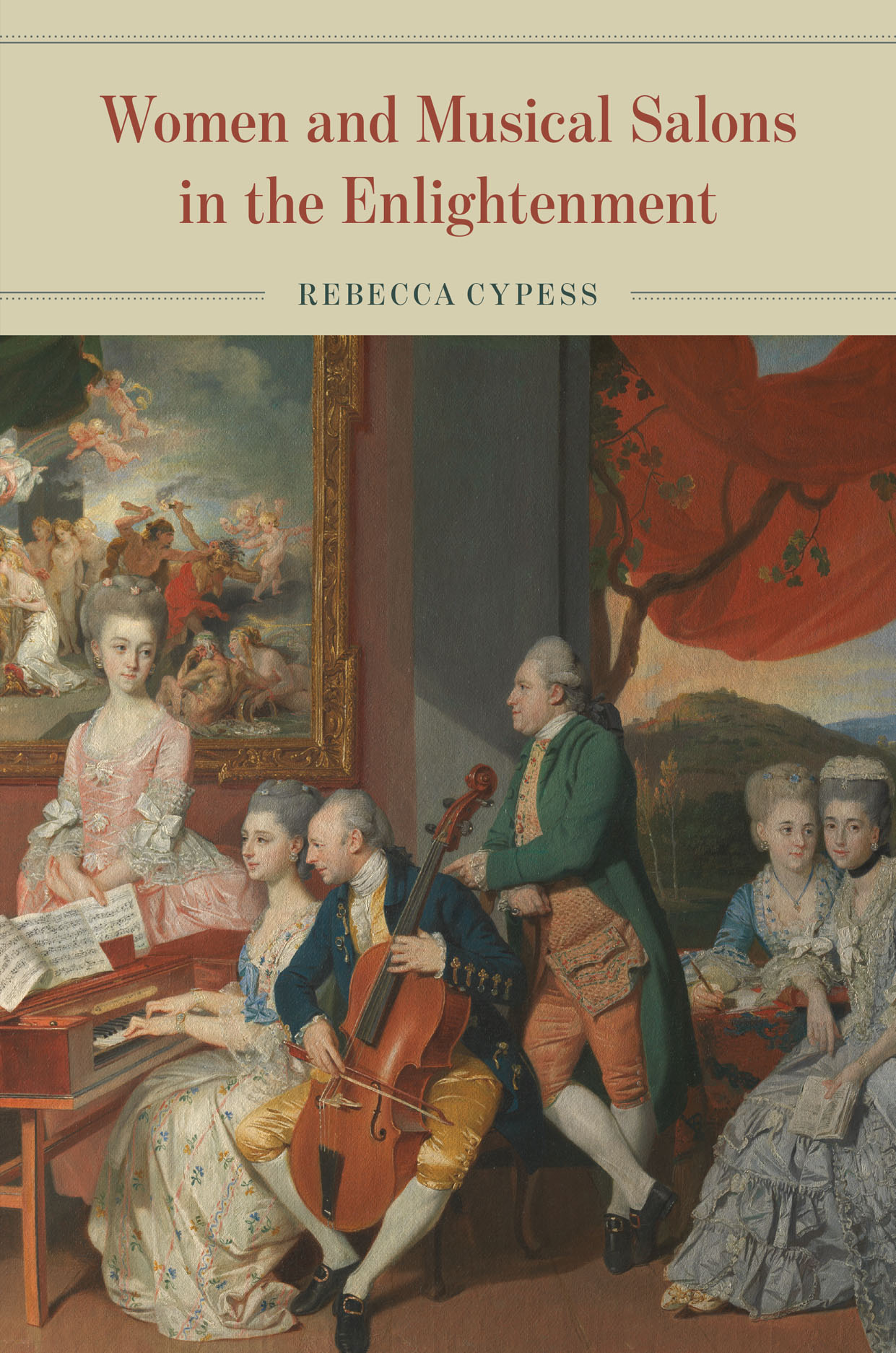 Women and Musical Salons in the Enlightenment. Rebecca Cypess. Chicago: University of Chicago Press, 2022. 365 pp. 37 figures. ISBN: 97802268171910. $55.00.
Women and Musical Salons in the Enlightenment. Rebecca Cypess. Chicago: University of Chicago Press, 2022. 365 pp. 37 figures. ISBN: 97802268171910. $55.00.
Rebecca Cypess’s Women and Musical Salons in the Enlightenment is a comprehensive study of the involvement of women in mid-to-late-eighteenth-century European and American salons. As stated in the introduction “this book is about musical salons between roughly 1760 and 1800, and the women who hosted, governed, and made music in them” (5). The volume begins with detailed specifics about salon culture; subsequent chapters describe the salons of Madame Brillon, Marianna Martines, Sara Levy, Angelica Kauffman, and Elizabeth Graeme. Cypess’s previous research on Sara Levy informs the selection of salons but also included are “salons in which the hostess displayed a strong interest in music and in which music figured prominently in the proceedings” (5). The monograph demonstrates how women “used the musical salon as a site of cultural agency” (26). Cypess’s work is a resounding success in its detailed descriptions of the salons, the instrumentation and music performed, and the various roles women served in these establishments.
It goes without saying that feminist musicologists will find this topic of great interest, but the demographics to whom this work will likely appeal are broad. Cypess notes in the introduction that while “music lies at the center of this study,” she also includes “other arts, sciences, and cultural practices” (9). This is an understatement, as numerous interdisciplinary contexts are woven throughout the volume. Scholars interested in Colonial America will also find this book valuable; there are frequent references to and/or quotations from Benjamin Franklin, John Adams, Thomas Jefferson, and Francis Hopkinson, not only in the chapter dedicated to the American salon of Elizabeth Graeme, but sprinkled liberally throughout the entirety of the work. Cypess’s study may also be useful to American music scholars who have routinely found the country almost entirely omitted from surveys of the Enlightenment. Raised in a wealthy Philadelphia environment, Graeme, whose salon is the subject of Chapter 7, had family connections with colonial leaders, including Franklin, to whose son she was engaged for a time (283). (The family also owned slaves, although Cypess curiously glosses over this fact.) Finally, Cypess’s work will be of value to historians of musical instruments due to its fascinating discussion of curious keyboard instruments such as the “vis-à-vis combination fortepiano,” which, although a single instrument, resembles two pianos dovetailed, with keyboards on opposite ends to facilitate eye contact between two players. The author states this instrument enhanced the ability to “engage in musical sociability,” thus making its purpose distinct from concert or pedagogical instruments (79).
The open access companion website (http://press.uchicago.edu/sites/cypess) provides a wealth of information that complements the book beautifully. Not only does it include color versions of some of the images presented in black and white in the book, but it contains an extraordinary number of audio examples, recorded primarily on historical instruments, which bring the discussion to life. The author describes herself as a “historical keyboardist” who recognizes that “the act of playing reveals considerations that cannot be discerned through silent score study” (64). The author herself is featured playing a variety of different keyboard instruments (fortepiano, harpsichord, and square piano) on the companion website. The reader/listener can clearly hear the added ornaments and the free interpretation of rhythm. The balance, particularly with the softer instruments, is superb throughout. The repertoire, consisting primarily of chamber music, includes arrangements as well as original works for flute, violin, basso continuo, and solo keyboard by composers such as JS Bach, Marianna Martines, Francis Hopkinson, and CPE Bach. The images in the book sometimes have unclear backgrounds where the reader is meant to notice something specific. This is rectified by having the paintings available in color on the companion website which makes a world of difference particularly in Figure 3.1 featuring Jean-Honoré Fragonard’s L’Ètude, which depicts Madame Brillon (the focus of Chapter Three “Ephemerae and Authorship in the Salon of Madame Brillon”). Cypess notes the portrait as an example of Brillon’s preferred instrument (an English square piano) since it can be seen in the background of the painting; however, as one can clearly see it only on the website, the color image would have been a worthy inclusion in the printed volume.
Cypess’s research is of the highest quality. The bibliographic documentation is extensive, incorporating manuscripts and print sources from special collections and archives and providing plentiful resources for further study. Additionally, Cypess incorporates lengthy quotes from the women discussed to ensure that their vibrant voices are heard.
At times, the non-musical details seem excessive. This reviewer personally found them quite interesting, particularly the discussion of anti-Semitism in the “Polemics on Ancient Hebrew Music and the Music of the ‘neue Juden’” section of Chapter 5, the chapter on the salon of Sara Levy (214-26). This type of context is critical to understanding the issues that Jewish women such as Levy faced during this time. As Cypress makes clear, “Jewish women were not welcome in the homes of gentile women” (203). Although the author explains why she believes the amount of detail she provides is required, it does leave the reader at times wondering when the topic will circle back to women or music. A similar issue occurred in Chapter 7, where extensive coverage of the paraphrases of the Book of Psalms was excessive, although a musical connection is eventually presented (that Graeme was “not just ‘all ear,’ but also a contributor to this musical-poetic tradition”) (310).
These minor details aside, Cypess’s research is outstanding and fills a notable void in the literature, rendering this book of great value to scholars of several disciplines. The work is meticulously and artfully written and will be a great asset to any library.
